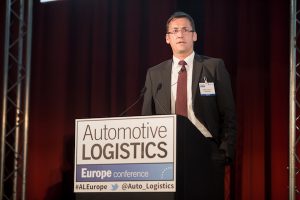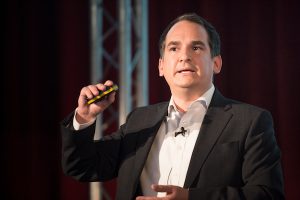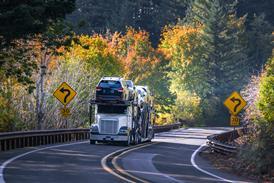The 2017 Automotive Logistics Europe conference reminded delegates that, despite a better economy, the industry is under pressure. However, new technology looks set to offer the supply chain as much opportunity as disruption, if companies are able to keep up. Marcus Williams, Christopher Ludwig and Gareth Tredway report from Bonn, Germany

When it comes to planning and managing the automotive supply chain in Europe these days, nobody said it was going to be easy.
European new vehicle sales and production may be heading in the right direction for the third year in the row, but the industry is contending with geopolitical and economic threats in the region or with neighbours. Violence in the Middle East and the ensuing refugee crisis, along with unstable relations with Russia and Turkey, have already disrupted supply chains and knocked vehicle sales in some countries well off prior levels.
Britain’s decision to leave the EU, meanwhile, faces no shortage of risks to the flow of goods and parts between the UK and the continent. In some worst case scenarios, if Brexit were to happen in 2019 without a comprehensive free trade agreement in place, it could lead to a substantial fall in UK vehicle production, while also posing a risk to the flow of many European-built cars that are exported to Britain. The uncertainty following the recent UK election only underlines this risk.
[in_this_story align="right" border="yes"]The US, meanwhile, one of Europe’s most important trading partner, now has a president who regularly criticises free trade, notably German automotive exports to the US, something he has already threatened to “change”, including through the imposition of tariffs and protectionist measures. Donald Trump’s decision to pull the US out of the Paris climate agreement, meanwhile, is but a further signal that European politics, business and regulations could see divergences that impact the automotive industry.
The automotive industry is also facing tremendous technological, economic and even social changes, some of which will strain financial resources further. Carmakers are pouring billions of euros into developing autonomous vehicles, for example, without knowing when to expect a return. Likewise, manufacturers are investing in electric vehicles, while facing sales declines (and mounting regulatory pressure) on diesel vehicles, which make up a significant share of European powertrain production.
All this is happening in the context of a long-term sales trend that is mostly flat, with relatively low growth. Christoph Stürmer, global lead analyst at PwC Autofacts, predicted that carmakers will compete intensely for any small pocket of high growth – such as crossover models or electric vehicles – but the pressure on margins and resources will be high. General Motors’ decision to sell Opel/Vauxhall to Groupe PSA is perhaps an example of the further consolidation and fallout that may follow in the European sector.
Taken altogether, Stürmer said it was almost as if the automotive sector were facing the “perfect storm”.
“The automotive industry is in a state of collected panic. Something is happening out there. We are seeing a whole industry fearing immediate extinction,” he said.
- Using logistics to compete across a digitalised aftermarket
- Two thirds of UK car manufacturing 'could move to the EU within a year'
- Vehicle logistics: Data sharing could ease port constraints
- Automotive manufacturers could hitch a ride to China
- Carmakers already saving costs with 3D printing
- Live polling results
Over a five-year period, PwC doesn’t expect much by way of growth, but still European light vehicle production should still increase by 1.5m units.
Indeed, even after they years of sales declines that followed the financial crisis, the European automotive sector has not been hallowed out and shipped off to lower cost countries in Asia, or nearby locations like Turkey or North Africa. Instead, plant capacity utilisation is once again above 80%, according to PwC, and many plants both in western and central Europe have seen upgrades, with new plants in Poland, Slovakia and Hungary, and expanded facilities in Germany, Spain and the UK.
Plus, in the face of competition from Silicon Valley and tech firms, European carmakers are investing heavily to keep up with the latest technology both in-vehicle and in production.

“Europe is not a boring place, lately,” admitted Stürmer.
[sta_anchor id="1"]The only way is EASCYThings may not be easy in Europe, they are set to be EASCY – PwC’s new acronym to describe the next generation of passenger vehicles, standing for electrified, autonomous, shared, connected and yearly updated. It’s a summary of the directions that echoes the long-term strategies outlined by European carmakers including BMW, Volkswagen and Mercedes-Benz (whose own acronym, CASE, stands for connected, autonomous, shared and electric).
Others, such as Kia, share similar outlooks. Carlos Lahoz, director of sales and business planning and supply chain management at Kia Motors Europe, said consumer expectations for connected cars would only increase. He cited a 2016 survey in which 41% of car buyers had picked connectivity as a key decision factor in whether or not they would change car brands in the future. This is up from just 20% in 2014.
“In the connected age, the car as we know it today will be history,” said Lahoz. “Because, alongside our home and our office, the car will become a living environment.”
Lahoz also agreed that product development cycles would also shorten dramatically, especially given the relatively shorter lifespan of software products and the need to update technology.
“The era of one product development cycle for everything in the car is over,” he proclaimed.
Very challenging for carmakers, EASCY isn’t so simple for suppliers or logistics providers either. Already, a number of suppliers have been completely revamping their business models for a new era. Delphi, for example, has now sold off most of its powertrain division, focusing more on sensors and connected car technology. Johnson Controls, meanwhile, spun off its seating and interior business, while merging with security solutions and fire protection technology provider, Tyco.
Johnson Controls is now built on two pillars, according to Frank Vorrath, vice-president for global supply chain. One is focused on building technology and connected facility solutions, and the other involves power solutions, including supplying car batteries to the automotive industry.
“We live in a world where we don’t compete as companies anymore, we compete as ecosystems,” said Vorrath.
The level of new technology in the passenger vehicle is also affecting the supply of parts to factories and to the aftermarket, as well as the movement of vehicles from plant to dealer.
 Carlos Lahoz, director of sales and business planning and supply chain management at Kia Motors Europe
Carlos Lahoz, director of sales and business planning and supply chain management at Kia Motors EuropeMore sophisticated automation, artificial intelligence and data-driven algorithms are changing processes across the supply chain, and challenging the status of traditional players. Future business models are being tested and developed based on the gathering of big data, e-commerce strategies and the application of new processes including 3D printing.
At the same time, e-commerce and new players in mobility providers, including shared cars and ride hailing, are eroding the boundaries between manufacturing, sales and service in vehicle and aftersales markets.
And yet, the risks may be matched by opportunities. Manufacturers, suppliers and logistics providers are exploring new tools and systems to digitalise processes across logistics, especially for tracking, network optimisation and in assisting workers. The Volkswagen Group, for example, is exploring ways to use digital technologies to make its logistics processes more integrated, user friendly and more automated across its brands. Agricultural manufacturer AGCO, meanwhile, is using a transport management system (TMS) and centralised management process to optimise its global supply chain.
For finished vehicles, carmakers are also starting to work more closely together, including with logistics providers, to make better use of in-vehicle telematics systems as a better means to track vehicles and communicate in the supply chain. Meanwhile, systems to better monitor various stages of the vehicle supply chain are also helping to improve inventory management and visibility in port terminals and at sea.
Manufacturers and equipment providers are exploring the potential for various kinds of planning and training tools, including virtual reality or ‘digital twins’ in which factory and supply chain processes can be validated prior to implementation.
Elsewhere, increased connectivity and faster internet speeds are also set to open up new possibilities across the supply chain. The expected rollout by 2020 of the fifth generation of communication standards, 5G, could provide major benefits to a number of sectors in future, including logistics, as it will address some of the current limits, according to Veronika Söntgerath, connected mobility executive consultant at T-Systems.
"The automotive industry is in a state of collected panic. Something is happening out there. We are seeing a whole industry fearing immediate extinction" - Christoph Stürmer, PwC
Benefits of 5G technology includes more widespread broadband access and very high internet speed, which would include a larger capacity to track and manage transport data across roads and cities. Söntgerath said that would be an enabler for smarter logistics, as well as for autonomous driving.
While so much discussion continues to be around digitalisation – so-called ‘industry 4.0’, as it is often called, especially in Germany – manufacturers and logistics service providers are also working together to further improve productivity, reduce waste and emissions. Ford has saved millions of euros with simple, yet effective engineering improvements and standardisation in packaging, for example.
There has also been a strong focus on reducing emissions and pollution in the supply chain. UECC, for example, has launched two dual-fuel LNG ro-ro vessels to serve the European short-sea network, a first in the sector. UECC’s move was followed by announcement from Volkswagen Group that it, too, would charter two LNG vessels to serve on deep-sea trades, which are expected to come into service in 2019.
On the road, meanwhile FCA’s in-house carrier, i-Fast Automotive Logistics, has worked with Iveco to build a fleet of LNG-powered trucks to move finished vehicles. According to Marco Simone Zanna, head of i-Fast, the equipment reduces particulate matter by 96%, nitrogen oxide by 32% and carbon emissions by up to 15%. With a range of 1,500km, and a growing number of filling stations in Europe, there was potential to increase use of the equipment further.
EASCY or otherwise, it will be a tough road ahead in Europe – but there are reasons to believe that the path will lead to rewards.
[sta_anchor id="2"]Volkswagen’s great DiscoveryDigitalisation may often be discussed in terms of transformation and disruption, but in logistics, at least, not every carmaker is treating it this way. Some executives point to the potential of using technology to make current tasks easier, or to make business tools as user friendly as the smart phones and tablets that people are now to used to in their personal life.
 Matthias Braun, head of network planning and location projects for VW Group logistics
Matthias Braun, head of network planning and location projects for VW Group logisticsAt the Volkswagen Group, Matthias Braun, head of network planning and location projects for group logistics, said that his division has taken a practical approach to digital technology. While Volkswagen Group brands and plants are trialling different kinds of technology, from drones to AGVs, group logistics – which manages common standards and consolidated logistics throughout the group – has defined key characteristics for determining its approach to logistics digitalisation.
Firstly, the project should involve the transfer of a manual process into an IT-supported one; second, it should enable additional benefits through the use of digital technologies.
With that in mind, one of the most important first steps for the group has been the establishment of an open platform called Discovery that communicates pickup and arrival information about inbound parts across suppliers and carriers. According to Braun, the aim is to get everything that is relevant to the parts supplier and the plant onto one database, and to make the information available to everyone involved with the daily delivery of those parts to the plant.
“Our group plans where we have our part call offs to the supplier,” explained Braun. “The supplier informs the carrier today what to pick up tomorrow, and the carrier brings it to us. In the communication between the supplier and carrier, everything is allowed.”
"[Discovery] is an open platform and we work with an IT partner who is programming it on open standards for everyone to use. We know that we are not alone in this world and must work together for efficiency." - Matthias Braun, Volkswagen Group
Through a web-based platform, information is transferred by EDI to Volkswagen Group carriers and there is no longer any need for the carrier to manually re-enter the information into its own system as a transport order, explained Braun.
The supplier gets confirmation of when the parts will be picked up the next day in a much more accurate window. Up to now, the supplier could expect a pick up by the carrier at any time between 6am and 10pm. With the Discovery system, the carrier comes back with the information about the pick up more quickly and can identify which hour of the day it will be there for the parts.
“This is all transparent via EDI and we get the information earlier in our plants because we know from the transport request that the parts ordered based on our call off will be picked up the following day so we have a day's more visibility where we can start reducing our stock,” explained Braun. “This is an open platform and we work with an IT partner who is programming it on open standards for everyone to use. We know that we are not alone in this world and must work together for efficiency.”
Volkswagen Group expects to have about 80% of its carriers in Europe using Discovery by the end of this year, with plans for further rollout to follow.
[sta_anchor id="3"]Designing out volatilityDigital technology is also helping the commercial vehicle sector manage the volatile nature of its supply chain. Regular swings in demand of 20-30% have led equipment maker AGCO to develop a more integrated planning approach in an effort to bring down transport and inventory costs, according to Buelent Ileri, AGCO’s director of transport and logistics for the Europe, Africa and Middle East region.
 Buelent Ileri, AGCO’s director of transport and logistics for the EAME region
Buelent Ileri, AGCO’s director of transport and logistics for the EAME regionIleri pointed out that, until recently, AGCO’s multiple brands and plants managed their logistics separately, with limited cross-plant cooperation, and fragmented implementation of logistics practice and static planning. To improve cost and performance, Ileri said that the company realised it needed to coordinate and plan these logistics.
Rather than create a large central organisation that would require hiring substantially more new staff, or to wholly outsource operations, Ileri said the company decided to go with a “hybrid” approach by partnering with supply chain software expert 4Flow, which acts as a neutral 4PL to manage and optimise transport flows using a global TMS. The system is now currently in action at 20 of AGCO’s sites around the world and involves 8,000 transport orders per month.
The move to a digital system followed a study conducted by AGCO into how to adapt its transport model on a daily basis and get better results given the variable nature of its supply chain. Although production volumes are relatively small – producing 60-80 tractors per day across the network in Europe, for example – the products are entirely customised, and subject to highly seasonal and variable demand.
“We focused in our initiative on transportation because transport is 60% of inbound supply chain costs,” noted Ileri. At this point the companies have implemented around 350 savings measures and reduced transport costs by 28%. The company has also reduced inventory days on hand by 24%.
Julian Schulcz, executive vice-president of supply chain at 4Flow, explained that the two main objectives the software provider faced were to reduce cost by better utilisation of assets and increase performance in the supplier network.
“The factories are in the spotlight but it is the suppliers that keep them going,” reasoned Schulcz. “So we contact them regularly. There is volatility in the network but we look to see how fast the dots are changing and how volatile is the shipment size. There are changes in size and weight on daily basis. It will always be that way but we will handle it.”
That meant a rigorous integration of planning and execution processes, something that is lacking in many automotive companies, he added. Using cloud-based IT tools and big data gathering, the TMS supports all transport processes from planning to execution. Planning is now also organised on different timescales, with long-term planning of what the network will look like over the next few years and daily choices made on transport needs. The company is also looking at the ‘near future’ and transport planning over a number of months ahead.
“We are planning the network design of next year and how volumes will go up,” said Schulcz. “We have redesigned the network, decided on new hubs and carriers, transport flows, and over and over we redesign the transport modes and join the dots.”
 Julian Schulcz, executive vice-president of supply chain at 4Flow
Julian Schulcz, executive vice-president of supply chain at 4FlowWith Europe fully implemented, 4Flow has also been implementing the system in Asia Pacific, where it should be full in place by the end of the year. Most recently it has extended its support to AGCO’s facilities in the US and South America regions and expects full implementation by 2018 in both regions.
[sta_anchor id="4"]Supply chain’s digital twinIn many examples, executives discussed how implementing new technology was rarely just a simple way to solve problems or improve efficiency. Rather, choosing new types of automation, planning or optimising software often requires wide-ranging organisational and cultural changes, including staff training and planning.
One of the key approaches that digitalisation experts have emphasised is the use of a ‘digital twin’ to plan and simulate new logistics and production concepts. Digital twinning refers to the mapping of the physical world to a digital one that uses IoT platforms and software to replicate a physical object or asset.
According to Jan Cirullies, head of the department of digitalisation in logistics at Germany's Fraunhofer-Institute for Software and Systems Technology, the digital twin is the basis for connected supply chains and allows real time planning and control throughout the network.
“If each participant in the supply chain has an information link then it will provide visibility on where things are in your supply chain and you get transparency on what are the reasons and possible consequences when certain things occur,” said Cirullies.
Cirullies also pointed to the advantages for supply chain design and planning. “In future companies, such as OEMs, will provide individual services that have a digital twin that allows companies to orchestrate a service supply chain more dynamically and more flexibly,” he said.
 Jan Cirullies, head of the department of digitalisation in logistics at Germany's Fraunhofer-Institute for Software and Systems Technology
Jan Cirullies, head of the department of digitalisation in logistics at Germany's Fraunhofer-Institute for Software and Systems TechnologyDennis Kolberg, head of research at Innovative Factory Systems, part of the German Research Centre for Artificial Intelligence, spoke about how manufacturers should use digital twins to plan the changing structure of their assembly and logistics in plants. For example, the likely shift to more ‘modular’ production, with material moving autonomously across different workstations rather than a linear assembly line, would require considerable changes to current layouts.
“Carmakers looking to upgrade their factories today should try to look ahead to 2030, to prepare themselves for the changes,” he said. “Simulated models can help them to do this.”
Kolberg said successfully implementing these technologies was not only about connecting machines but also connecting people and companies together. He emphasised that attempts to focus on factory automation as a means to eliminate as many people as possible have generally failed.
“Instead, we need to look at how we can use technology to assist tasks, and give people the skills and training they need to make the best use out of new technology,” he said.
He gave an example of augmented reality glasses that in some use cases blocked workers’ periphery vision at his assembly workstation. Instead a projector above the workstation was used to provide the same function. In another example in the farming industry, he said record keeping just went back to using paper rather than smart tablets.
“Technology doesn’t solve everything, sometimes it is good, but not every time,” says Kolberg.
Boris Dul’a, chief executive and chairman of Slovak technology and automation firm, CEIT, also outlined a process to bring ‘smart factory’ concepts to life, such as for implementing automated guided vehicles.
The ‘factory twin’ or ‘digital twin’ is vital, he said. Not only can such systems simulate new equipment, but they should also be used to train employees and get them ready to use new technology, without having to take risks in real-world environments.
Furthermore, Dul’a emphasised that central control systems and data capture, including through sensors, cameras and other connected devices, needs to be in place to capture information once new equipment has been installed. Using such monitoring, improvements can be made to processes as quickly as possible. Meanwhile, data should be fed into analytics systems to again ensure maximum visibility of operations.
 Boris Dul’a, chief executive and chairman of Slovak technology and automation firm, CEIT
Boris Dul’a, chief executive and chairman of Slovak technology and automation firm, CEIT“These approaches need to be considered whether it is an upgrade to a brownfield factory or a newly built, greenfield site,” said Dul’a. “It requires the right attention to data and human skills as well as connected technology.”
[sta_anchor id="5"]Keeping data sovereignty intactData capture and analytics offer many opportunities to improve operations. Frank Vorrath from Johnson Controls suggested that companies could use the data extracted from various devices communicating with each other. Examples included preventative maintenance models, which are already a reality.
“We have to find new ways to use the data we can extract from our products and also the data from our customers and integrate it into our planning systems,” says Vorrath.
“By doing that we will be in a position to run our business in a more efficient way and connecting it further with our logistics and transportations systems.”
Carlos Lahoz from Kia also pointed to ways in which data captured from drivers using telematics could, for example, help dealers and carmakers to schedule repair and maintenance. Connectivity could also be used to download software updates remotely, potentially even handling some recall actions without the customer needing to come into a dealership.
However, speakers also agreed that the growth and sharing of data presented many risks. Vorrath suggested that security needed to be a focus point in the connected car future, both for consumers as well as supply chains.
“We have to talk about the risks, and not just the fancy opportunities that we all have,” he said.[mpu_ad align=”left”]
Jan Cirullies at Fraunhofer offered one potential solution by way of a cross-industry project, called the Industrial Data Space, which allows companies to share critical information, but keep it anonymous. It is a method that would protect some potential proprietary information. He explained to delegates that the technology provides automatic validation of current data from different sources and integrates it for use in predicting future scenarios through simulation. Importantly, however, Cirullies said that data sovereignty is not compromised.
“When we talk about the evolving supply chain we realise that digitalisation and data exchange are the key enablers for the supply chain as an eco system,” said Cirullies, adding that it was possible to bridge the gap between sharing data and making value out of it while still keeping it secure.
The practical applications are many. Cirullies mentioned the Fukushima nuclear disaster that happened in Japan following the earthquake and tsunami in March 2011. In the wake of such incidents, companies needed to connect dynamically and bring transparency to the supply chain, which they could do through the digital twin and the Industrial Data Space. Using these digital tools, demand requests could be easily pushed recursively through the supply network with suppliers providing information.
[sta_anchor id="6"]Moving outbound ahead againWhile much of the focus for ‘industry 4.0’, including smart factories and advanced automation, is on inbound, the finished vehicle logistics sector, with its focus on transport capacity, compound and terminal space, might appear behind in some ways.
Indeed, some in the sector acknowledge a gap between outbound and other segments of the supply chain and broader car sector. “I think compared to what is happening in [the automotive] industry, development in vehicle logistics is relatively slow,” said Torsten Heinrichs, manager of finished vehicle logistics for Ford in Europe.
“We are very conservative, actually old fashioned, in the outbound logistics field,” agreed Bjørn Svenningsen, head of sales and marketing at short-sea shipping provider UECC. “A lot of focus and effort has been put into the inbound side, because the plant can never stop.”
 Hervé Moulin, project leader for telematics in finished vehicle logistics, Renault-Nissan Alliance Logistics Europe
Hervé Moulin, project leader for telematics in finished vehicle logistics, Renault-Nissan Alliance Logistics EuropeHowever, over the past two years or so, much more has been happening in vehicle logistics to update processes, including for tracking and communication. For example, the connected car age has arrived, perhaps with some delay, to Europe’s vehicle delivery sector, as carmakers and logistics providers explore ways to use and standardise the information available from in-vehicle telematics and infotainment systems.
Hervé Moulin, project leader for telematics in finished vehicle logistics, Renault-Nissan Alliance Logistics Europe, described how using such systems to monitor vehicle location, battery voltage and fuel levels could prevent the loss of time and resources when transporting finished vehicles.
“Vehicles will also be able to receive instructions remotely such as flashing lights and door locking, which will be of good use in the finished vehicle process,” added Moulin.
Paul Nurse, chief executive of ProAct International, a logistics management software company, pointed to benefits for outbound transport and tracking systems, including gaining access to vehicle GPS positions, tyre pressure warnings, remote door locking, fuel levels and batter charge states – something that will become especially important as more electric vehicles are built and sold.
“We can start to make improvements in terms of maintenance and dwell time,” said Nurse.
“We can then decrease the amount of maintenance, not only because we are pre-empting the problem but also because we don’t necessarily have to charge every [battery] every thirty days because we think we have to, we can just address the ones that have a particular battery issue.”
However, to take full advantage of these capabilities, Moulin said a standardisation process was required for the use of telematics in the finished vehicle logistics sector. “It is important to realise that a vehicle is no longer limited by its physical boundaries,”said Moulin.
"We are very conservative, actually old fashioned, in the outbound logistics field. A lot of focus and effort has been put into the inbound side, because the plant can never stop" - Bjørn Svenningsen, UECC
“Now that it has communication capabilities, they must also be standardised.”
Paul Nurse agreed that, for logistics providers and IT companies, using telematics would not be as simple as communicating directly with a vehicle. Instead, most communication would remain with the OEM and through its own systems.
“The reality is, in the short term, we won’t be able to talk directly to the vehicles. We will have to talk to the OEMs and get that data via them,” said Nurse.
“It will make the LSPs systems critical, because those are the systems that will have to process all that myriad of data that will be coming at them and make sense of it and leverage it.”
[sta_anchor id="7"]Carmaker communicationTo manage this proliferation of data in its various forms across different carmaker systems, a project involving various OEMs, software and logistics specialists has been established, together with the Association of Europe Vehicle Logistics (ECG), to work on communicating across OEM systems using a web-service interface.
This interface will be able to communicate and standardise data provided by the vehicles, what orders can be sent to the vehicle, as well as the data exchange format and process.
“It is important to note that the communication between the vehicle and the OEM’s cloud platform would not need to be standardised,” said Moulin. “What we do need to standardise the communication between the cloud platform of the OEM and the data management system of the logistics suppliers.”
Such standardisation becomes all the more necessary for OEMs that are cross manufacturing a number of different models of vehicles – such as Renault Nissan – as well as for logistics providers that have a large number of different brands of vehicles on the same compound, for example.
 Paul Nurse, CEO, Proact
Paul Nurse, CEO, Proact“If we don’t have standardisation between the vehicles and logistics providers, we will have problems handling our vehicles and taking full advantage of telematics,” said Moulin.
At ProAct, which is also part of the digitisation working group, Paul Nurse agreed on the importance of creating standards for using telematics for finished vehicle logistics.
“If we are going to do this, ideally we will need standards where we know that when any brand of vehicle comes through our facilities, we can accept information in a standardised way,” he said.
“One of the challenges we have is to convince OEMs generally that there is some value in sharing their data with service providers.”
The OEM working group was actually formed following a discussion at the 2016 Automotive Logistics Europe Conference, and the parties, including several logistics providers, met later in last year at Jaguar Land Rover’s head office to begin discussions.
“In this meeting the main building blocks for standardisation were outlined and the roadmap was created to associate other LSPs and OEMs,” said Moulin.
Today, participating OEMs have increased to 12, along with a number of logistics and software providers.
“There was an LSP meeting in January this year to list the most interesting use cases, and these use cases were confirmed on the OEM side at the latest ECG Digitalisation Working Group on April 28th,” said Moulin
The objective is to provide detailed specifications by March 2018.
Collaboration and integrationImproving data communication and links across the vehicle logistics chain was an objective that also went beyond the possibilities of telematics. With shipping and terminal capacity getting tight, for example, Torsten Heinrichs, manager of finished vehicle logistics for Ford in Europe (excluding the UK), said that the industry had to do more than just offer new capacity or facilities.
 Torsten Heinrichs, manager of finished vehicle logistics for Ford Europe
Torsten Heinrichs, manager of finished vehicle logistics for Ford Europe“But I think to achieve an overall improvement in the supply chain, we need to have a deeper look together,” he said.
Heinrichs emphasised the need for smarter, more flexible networks and called for more collaboration between all players in the network to properly alleviate the problem.
“I think to achieve an overall improvement in the supply chain, we need to have a deeper look at how we work together, we need to work on the processes and we need to work together to connect the dots,” said Heinrichs.
He invited finished vehicle logistics players to use the technology changes happening within the automotive sector as motivation to improve their own processes and become more efficient.
He also called for more innovation across the whole supply chain and across different transport modes. “We need to do more research together, we need to understand better, we need to experiment and solve – all the way from the OEM to the customer,” he stressed.
Bjørn Svenningsen also called for more collaboration and systems of integration between logistics and OEMs, as digital data and communication platforms may play a significant role in alleviating bottlenecks. UECC has previously launched a digital platform to allow its OEM customers to access key information, for example.
Marc Adriansens, managing director at terminal operator ICO, highlighted digitalisation as a solution to the overcapacity and bottlenecks at ports. He said at port level, a data platform that gives all information from all modes including train, truck and ship information, including global positioning and weather forecasts, has gone a long way to getting accurate ETA’s of deliveries.
This would in turn allow for just in time allocation of resources including things like tug boats and parking spaces.
Manuel Medina, responsible for finished vehicle distribution planning at Spanish carmaker Seat, meanwhile, discussed the potential of using real-time data tools to eliminate some steps in the vehicle logistics process altogether. He discussed the concept of the ‘virtual compound’ that would eliminate the need to store cars at plants. The concept followed the need to reduce the amount of cars at Seat compounds by 30%.
“Virtual compounds are a holistic concept, containing all of the activities related to delivery and to improve the coordination between the factory and the transport company,” he explained.
He said the idea is to transform this handover point to one similar to inside the factory, where the vehicle moves from the painting workshop to the assembly line, or the connection between a just-in-time supplier and the line.
He stressed that part of the solution to achieve this included the need for smart communication methods. Seat already had a high degree of RFID connectivity for finished vehicles at its Martorell plant, as well as at the port of Barcelona, a major port of export. But he also pointed to the benefits of automated planning and optimisation systems.
 Manuel Medina, finished vehicle distribution planning, Seat
Manuel Medina, finished vehicle distribution planning, Seat“We need systems of communications that allocate the cars to suppliers in an automatic way,” said Medina.
[sta_anchor id="8"]Packing in savingsNot every opportunity for improvement comes down to high tech, digital solutions or systems. Rather, several executives highlighted the critical role that packaging can play in reducing both costs and carbon emissions.
Axel van het Kaar, carline supervisor for material flow and packaging engineering at Ford of Europe, who is responsible for managing in-plant logistics and packaging designed, pointed to millions of euros worth of savings across the carmaker’s standard and bespoke packaging.
The major improvement across Ford’s operation has been to increase the level of standardised packaging wherever possible. According to van het Kaar, standardised equipment now fits more than 90% of the parts and materials across Ford’s logistics. This includes not only load carriers and pallets across standard trailer and truck sizes, but also within bespoke packaging for special parts, and for more long-distance supply flows.
Examples can be simple but highly effective. For moving control panels, Ford had used dedicated cardboard inserts, however they not only had an individual cost, but many ended up getting lost in the transfer of parts. Ford switched to standard equipment built into the packaging and has saved considerable money.
In other cases, Ford has been able to save costs and emissions on intercontinental logistics flows. The use of a standard ISO bin, for example, can be used for shipments, and then put back into a common pool to be used by other customers.
There are also examples where Ford has moved to cardboard to gain savings. For moving some larger parts between South Africa and Thailand, for example, Ford had traditionally used steel racks for extra protection, which then needed to be sent back for return. However, a switch to cardboard has yielded no further increase in damage rates, and yet saves $50 on return freight.
Van het Kaar pointed to examples of somewhat more complex packaging engineering and innovation as well. In the bodyshop, Ford has recently introduced a ‘no touch pallet’, in which a robot sets pins on a pallet that will hold parts. The process used to be done manually, but not the robot knows where to place the pins and greatly increases the speed of the process.
It has also introduced a new recyclable material for dedicated trays. In this innovative example, the tray is formed using a machine in custom sizes. Once the supplier uses it and sends it to Ford, the tray is ground back to material, making it easy to ship. It can then be reformed into new tray sizes.
“Our overall goal is to use a standard wherever we can but not to limit our flexibility,” said van het Kaar. “We use this judgement when working with our engineers and packaging suppliers.”
Standard equipment takes a seatThere were other examples of how standard packaging was also a better solution for relatively long-distance just-in-sequence flows. Ernst Jan van Klinken, managing director of packaging specialist VMT Ecopack, provided several case studies on the shipment of finished seats and metal frames across long distances in Europe.
In one example, van Klinken showed how using a standard, foldable ‘Ecopack’ container, which includes special trays to hold all the material, played a key role in the efficiency of finished seats shipped to the VDL Nedcar in the Netherlands, which builds BMW Mini models, from a plant in Poland. The equipment ensures a high fill rate, with 60 complete seat sets in each megatrailer, and a high return rate of 210-240 per trailer.
Thanks to their specialised design, the containers can move straight from the loading dock to their point of use on the assembly line, without needing to be stored or handled further.
 Ernst Jan van Klinken, managing director, VMT Ecopack
Ernst Jan van Klinken, managing director, VMT EcopackIn another example, the container was also used to metal frames for Lear car seats from Ostrava, Czech Republic to Györ, Hungary for seat assembly. The transport includes the movement of around 1.75m metal frames (two of which form a car seat). Based on a seven-year model cycle, and also considering the emissions used in production of the packaging, van Klinken showed that using a VMT container had less than half the carbon footprint of using a gitterbox (a type of steel cage), and less than a third the level of emissions of using a cardboard box on a wooden pallet.
“For the automotive industry, it is paramount to minimise the environmental impact of packaging in supply chain and logistics to get to the same level of environmental responsibility in the supply chain as products – such as vehicles – themselves,” he said.
[sta_anchor id="9"]Catching up and keeping aheadThe focus on connectivity among OEMs and logistics providers suggests that the industry is working towards advances that may be long overdue. Indeed, while there are interesting projects underway in areas like telematics tracking and measuring vehicle data, in many ways the automotive logistics industry is behind other sectors in such areas.
Veronika Söntgerath, from telecoms provider T-Systems, reminded delegates that the ‘connected car’ was actually nothing terribly new. In-vehicle telematics systems first started appearing in some vehicle in the 1990s. Meanwhile, she described the connected car as a “legacy”, as her company has been implementing it since 2003.
The question of keeping up with change could give executives pause, not least given the host of changes on the way. Will the industry be ready, for example, to handle the rise in alternative energy vehicles sales and production, which PwC’s Stürmer estimates will grow from 617,000 last year to 3.7m in 2023? Will Europe be able to cope with the drastic transition away from diesel engines? Will the shift towards autonomy be met in the supply chain with equal advances in logistics and supply chain?
“Why are [automotive manufacturers] in collective panic, and you logistics providers sitting so cool?” Stürmer asked the audience.
 Veronika Söntgerath, connected mobility executive consultant, T-Systems
Veronika Söntgerath, connected mobility executive consultant, T-SystemsFew doubted the irony in his question. In truth, few are sitting so cool and easy, at least not any longer. Most executives from manufacturers and logistics providers at the event were very aware of the EASCY future, and were investing in ways to improve their processes through digitalisation, whether by automating manual, paper-based tasks, or using new kinds of equipment to improve parts handling or network planning. Data management and security are high on the agenda, as are increasing cross-industry collaboration and dialogue to ensure digital standardisation as well as physical ones for transport and packaging.
For Stürmer, the opportunities in the coming disruption also need to be kept front-and-centre for supply chain partners. “You need to understand that your manufacturing customers are having a very bad time. If you can help them with current and upcoming worries, you’re in for a good time.”
To view the videos from the conference, click here
The Automotive Logistics Europe Conference is part of the global Automotive Logistics series of conferences
The next conference is Automotive Logistics Russia in Moscow on July 4-5th































